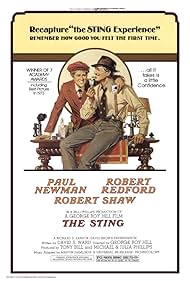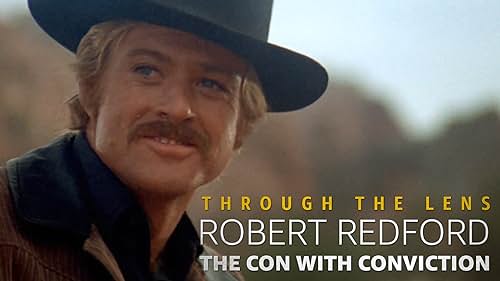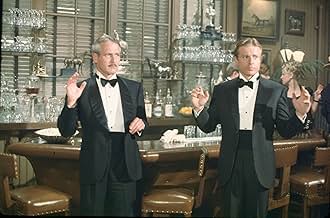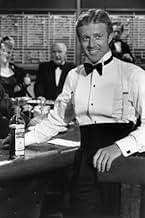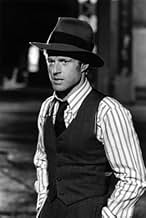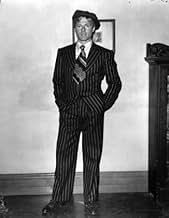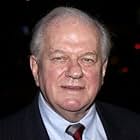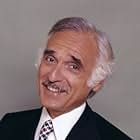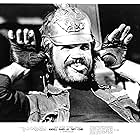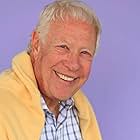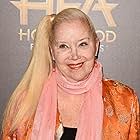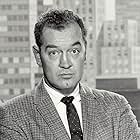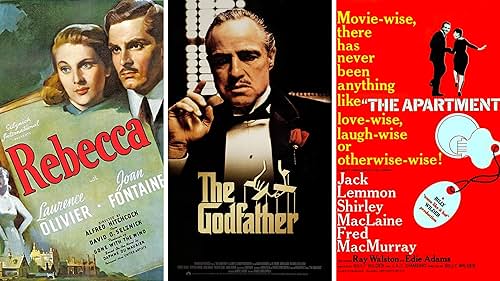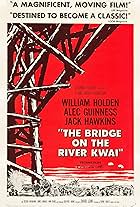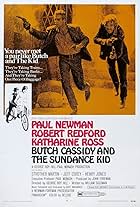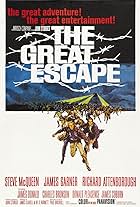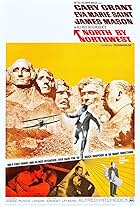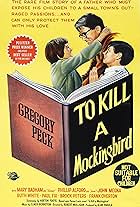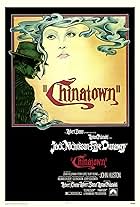Two grifters team up to pull off the ultimate con.Two grifters team up to pull off the ultimate con.Two grifters team up to pull off the ultimate con.
- Won 7 Oscars
- 18 wins & 6 nominations total
Robert Earl Jones
- Luther Coleman
- (as Robertearl Jones)
James Sloyan
- Mottola
- (as James J. Sloyan)
- Director
- Writer
- All cast & crew
- Production, box office & more at IMDbPro
Best Picture Winners by Year
Best Picture Winners by Year
See the complete list of Best Picture winners. For fun, use the "sort order" function to rank by IMDb rating and other criteria.
Storyline
Did you know
- TriviaGeorge Roy Hill used some 1930s stylistic techniques. The film starts with a 1930s-era Universal logo, and used editing wipes to transition between scenes and iris shots.
- GoofsIn the bathroom, Hooker can be seen saying, "He didn't tell me you was a fuck-up either." This has been looped to replace it with the less profane "He didn't tell me you was a screw-up either." (The grammar error is scripted.)
- Quotes
Johnny Hooker: Can you get a mob together?
Henry Gondorff: After what happened to Luther, I don't think I can get more than two, three hundred guys.
- Crazy creditsThe opening animated logo for Universal Pictures is in 1930s style, matching the movie's setting, instead of the 1970s version.
- ConnectionsFeatured in Oscars, Actors and The Exorcist (1974)
Featured review
The fix is in, the odds are set, and the boys are ready to play for the big time, both on the screen and behind the camera in this breezy, endlessly entertaining movie classic.
Robert Redford is small-time hustler Johnny Hooker, happy to play the marks in Joliet until the murder of his mentor pushes him to go up against the nastiest mug in Chicago, Doyle Lonnegan (Robert Shaw.) Hooker'd rather ice Lonnegan outright, but will settle for a big con with the help of a slightly wobbly but game scammer named Henry Gondorff, played as only Paul Newman can.
Newman and Redford, along with director George Roy Hill, had a lot riding on this pony, given it was a follow-up to their earlier "Butch Cassidy And The Sundance Kid." To measure up, they had to produce nothing short of another classic. And so they did. "The Sting" won the Best Picture Oscar in 1973, and remains the sentimental favorite among many in choosing between the two films.
Comparing "The Sting" to "Butch Cassidy" is kind of overdone sport, and tempers, as Lonnegan would say, run hot. But you can see why "The Sting" worked as well as it did by looking at how the director and the stars played it differently within the same basic framework as "Butch Cassidy." Newman and Redford are again outlaws and underdogs. Period detail abounds here as it did with "Butch Cassidy," and there's another memorable score amid the proceedings, Scott Joplin rags modernized by Marvin Hamlisch. The score even produced another hit, "The Entertainer," to compare with "Raindrops Keep Falling On My Head."
What's different about "The Sting," and what makes it such a classic in its own right, is the way the stars service the plot. In "Butch Cassidy," Newman and Redford's comradeship was the story. Here, the chemistry between the two actors is minimized in favor of spinning a yarn with enough red herrings to feed the Swedish navy. The tale here is better than "Butch Cassidy," which is a more elegiac film with grander cinematography and funnier set pieces. "The Sting" is an edge-of-your-seat caper flick from beginning to end.
You can't really call "The Sting" a comedy. Though there are many laughs, especially when Newman hooks Shaw during a poker game, Hill won't let the audience relax enough for that. What this is is a con game, played on the audience, designed not to cheat but entertain by means of clever hoodwinking and constant misdirection plays.
You'll get no spoilers from me. This is one worth sitting through with no expectations. Five gets you ten you'll enjoy Newman and Redford, and a terrific supporting cast (one advantage over "Butch Cassidy") that includes Charles Durning, Eileen Brennan, Dana Elcar, Harold Gould, and Mr. Hand himself, Ray Walston. There's another familiar face from "Butch Cassidy," Charles Dierkop, Flat Nose Curry in "Butch Cassidy" and Lonnegan's right hand here. The best performance may be Robert Shaw's; he exudes menace aplenty but some humanity, too, when he takes Hooker under his wing after learning he came from the same hard streets of Five Points Lonnegan sprang from.
Terrific period detail, too. The dialogue is great and feels real in its Runyonesque way, while the cons are elaborate and logically played out. Watching this a second time is especially fun because once you know how the plot goes down, you find yourself catching clues you missed the first time, and enjoying the film even more for them.
Why didn't Newman and Redford team up again? Certainly there was another good movie for them to partner up in, but as Gondorff would have put it, only chumps don't quit when they're ahead.
Robert Redford is small-time hustler Johnny Hooker, happy to play the marks in Joliet until the murder of his mentor pushes him to go up against the nastiest mug in Chicago, Doyle Lonnegan (Robert Shaw.) Hooker'd rather ice Lonnegan outright, but will settle for a big con with the help of a slightly wobbly but game scammer named Henry Gondorff, played as only Paul Newman can.
Newman and Redford, along with director George Roy Hill, had a lot riding on this pony, given it was a follow-up to their earlier "Butch Cassidy And The Sundance Kid." To measure up, they had to produce nothing short of another classic. And so they did. "The Sting" won the Best Picture Oscar in 1973, and remains the sentimental favorite among many in choosing between the two films.
Comparing "The Sting" to "Butch Cassidy" is kind of overdone sport, and tempers, as Lonnegan would say, run hot. But you can see why "The Sting" worked as well as it did by looking at how the director and the stars played it differently within the same basic framework as "Butch Cassidy." Newman and Redford are again outlaws and underdogs. Period detail abounds here as it did with "Butch Cassidy," and there's another memorable score amid the proceedings, Scott Joplin rags modernized by Marvin Hamlisch. The score even produced another hit, "The Entertainer," to compare with "Raindrops Keep Falling On My Head."
What's different about "The Sting," and what makes it such a classic in its own right, is the way the stars service the plot. In "Butch Cassidy," Newman and Redford's comradeship was the story. Here, the chemistry between the two actors is minimized in favor of spinning a yarn with enough red herrings to feed the Swedish navy. The tale here is better than "Butch Cassidy," which is a more elegiac film with grander cinematography and funnier set pieces. "The Sting" is an edge-of-your-seat caper flick from beginning to end.
You can't really call "The Sting" a comedy. Though there are many laughs, especially when Newman hooks Shaw during a poker game, Hill won't let the audience relax enough for that. What this is is a con game, played on the audience, designed not to cheat but entertain by means of clever hoodwinking and constant misdirection plays.
You'll get no spoilers from me. This is one worth sitting through with no expectations. Five gets you ten you'll enjoy Newman and Redford, and a terrific supporting cast (one advantage over "Butch Cassidy") that includes Charles Durning, Eileen Brennan, Dana Elcar, Harold Gould, and Mr. Hand himself, Ray Walston. There's another familiar face from "Butch Cassidy," Charles Dierkop, Flat Nose Curry in "Butch Cassidy" and Lonnegan's right hand here. The best performance may be Robert Shaw's; he exudes menace aplenty but some humanity, too, when he takes Hooker under his wing after learning he came from the same hard streets of Five Points Lonnegan sprang from.
Terrific period detail, too. The dialogue is great and feels real in its Runyonesque way, while the cons are elaborate and logically played out. Watching this a second time is especially fun because once you know how the plot goes down, you find yourself catching clues you missed the first time, and enjoying the film even more for them.
Why didn't Newman and Redford team up again? Certainly there was another good movie for them to partner up in, but as Gondorff would have put it, only chumps don't quit when they're ahead.
Details
- Release date
- Country of origin
- Language
- Also known as
- El golpe
- Filming locations
- Production companies
- See more company credits at IMDbPro
Box office
- Budget
- $5,500,000 (estimated)
- Gross US & Canada
- $156,000,000
- Gross worldwide
- $156,000,000
- Runtime2 hours 9 minutes
- Color
- Aspect ratio
- 1.85 : 1
Contribute to this page
Suggest an edit or add missing content

